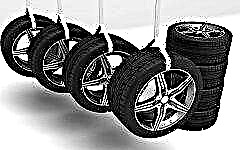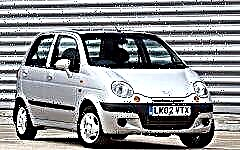

The content of the article:
- Duge (China)
- Confederate Bridge (Canada)
- Dancing Bridge (Volgograd)
- Kuandinsky bridge (Transbaikalia)
- Mackinac (USA)
- Passage du Gua (France)
- Storsezansedt Bridge (Norway)
The bridges themselves are awe-inspiring for drivers, and the unpredictable water element below adds spice to any crossing. But there are really creepy structures in the world that literally make your knees shake.
Duge (China)

In the photo: Duge Bridge - high-altitude record holder
China never ceases to amaze the rest of the world with its rapid achievements and unique creations. One of these is the suspension bridge over the Beipanjiang River, which is the world's highest road crossing.
Due to the peculiarities of the mountainous terrain, this cable-stayed bridge received an unusual and complex structure. In addition to steel cables - cables - the roadbed is reinforced with a system of trusses in order to maximize the stability and load-bearing characteristics of road spans with such a combination.
The bridge is 1.34 km long and four lanes wide by two irregular H-shaped pillars. Today it holds the record for height from span to ground, which is 564 meters. It's scary to even look at this floating bridge, and not what to move along it.
Confederate Bridge (Canada)

Photo: Icebreaker Bridge in Canada
The construction of such a grandiose structure, connecting Prince Edward Island with the mainland province of New Brunswick, required more than a billion Canadian dollars from the Canadian authorities.
The local landmark has impressive dimensions: length 13 km, width 11 meters, height 40 meters on the sides and 6 meters in the center, 44 spans of 250 meters each, 62 supports. Opened for traffic in 1997, it immediately showed its uniqueness as not only the longest bridge, but also an icebreaker at the same time.
The bridge is designed exclusively for the movement of vehicles, and its central part is specially raised so that water vessels pass comfortably under it.
The crossing required huge investments, since during its construction they tried not to damage the ecosystem. For this, the excavated soil was transported to other places to preserve the habitat of lobsters living here in abundance without harm to their numbers and their usual way of life. Therefore, in order to recoup the construction, a toll was set for the passage. The price fully justifies itself, as it makes it possible to cross the water hazard in just 12 minutes.
A ferry across the Northumberland Strait, it is designed to facilitate the movement of not only road, but also water transport. Due to the harsh climatic conditions, the strait is covered with a thick layer of ice every winter, so the engineers created a structure that lifts the ice cover, forcing it to break under its own weight.
The sight of ice breaking is impressive and terrifying, so drivers try to cross to the other side faster.
Dancing Bridge (Volgograd)

Photo: The most unpredictable bridge across the Volga
The Russian landmark, with sad glory, is one of the long-term construction projects that began in 1996. Local residents were eagerly awaiting its opening, since they had to spend a lot of time crossing the Volga-mother on a ferry or along the dam of the Volga hydroelectric power station. However, construction was completed only in 2009, but it turned out that the history of the bridge is just beginning.
It happens that some project does not go from the very beginning and even during its implementation does not bring success. Just 7 months after its inauguration, in windy weather, the bridge began to undulate in time with the raging Volga. Under the monstrous grinding of the support, the railings and the road surface shook under the driving cars, causing panic.
The bridge was urgently closed and over the course of several more years it was refined and made heavier. It is surprising that after the absolutely incredible "pirouettes" drawn by the bridge, neither the railings nor other elements of the structure were bent in the slightest degree, and the roadbed did not find a single crack.
Even engineers, architects and other road construction services cannot provide a logical explanation for this phenomenon.
Now, with 60 tonnes of weight added and its supports reinforced, it is considered one of the most reliable in the world. But numerous videos on the Internet will never let you forget the horror experienced by drivers and just eyewitnesses from the "dancing" crossing.
Kuandinsky bridge (Transbaikalia)

In the photo: Russian extreme in Transbaikalia - Kuandinsky bridge
Another unique crossing is located in the Trans-Baikal Territory in the village of Kuanda, which was once considered the "Small Capital of BAM".
The automobile bridge in this now dying out place is officially listed as an automobile backup for the BAM, in fact, it is a man-made "handicraft" for temporary needs. Built half a century ago, it was a temporary solution for crossing the Vitim River during the construction of the century, so it was built from improvised means.
Railway wooden sleepers, roll-up of boards, somehow fastened with steel plates and the width is exclusively for the passage of one car. Moreover, it has never been serviced for the entire period of its existence, therefore, almost all wooden elements rotted and crumbled into dust, and between the spans, difficult to overcome joints were formed.
Finally, it does not have a fence, and in the spring of 2018, during an ice drift, one of the supports was carried away. Therefore, overcoming this crossing can be compared to an extreme test of your own courage, and at the same time the maneuverability of your vehicle.
Mackinac (USA)

In the photo: Makinak Bridge is experiencing a wind force of 50 km / h
Since its construction in 1954 to this day, this crossing is the longest suspended type in the entire Western Hemisphere. This majestic structure, more than 8 thousand meters long, lies over the Mackinac Strait in Michigan and is a favorite tourist attraction.
Every day, tens of thousands of cars pass through it, and on Labor Day, tens of thousands of citizens in a kind of march for the sake of the "Walk Certificate", which gives the right to prizes and participate in lotteries.
So why is he dangerous? Exceptionally natural features, as a result of which a hurricane wind of 50 km / h constantly falls on the crossing. Therefore, a special service of drivers operates here, which ferry to the other side those cars whose owners themselves are afraid of being behind the wheel in such conditions.
Passage du Gua (France)

In the photo: those who did not manage to cross the Passage du Gua can say goodbye to their car
This crossing can rightfully be called underwater, since most of the day it is really covered with water from the Bay of Burneuf. Only twice a day, at low tide, the road becomes visible and allows motorists to cross to the other side.
In the 19th century, it was possible to cross the bay only by boat, until the waters receded, allowing the future road to be mapped. Although this structure is still difficult to call a full-fledged bridge, it received a hard surface and supports for safer movement, and on both sides of the entrances there are also signs with the schedule of ebbs and flows.
In addition, special rescue towers have been installed along the entire 4.5-kilometer length for those drivers who did not manage to cross before the water stream.In such a situation, you will have to say goodbye to the car, the unfortunate car owner himself can wait out the tide or wait for the rescue boat, sitting at a saving height.
The rapid onslaught of water, dense fogs and rather sharp changes in depth make this crossing one of the most dangerous in the world.
Storsezansedt Bridge (Norway)

Photo: miracles on bends in Norway
This stunning structure for its unusual design is nicknamed the "drunken" bridge, which will definitely not let the drivers relax.
The crossing is one of eight sections of the Atlantic Road connecting the Norwegian islands. With a length of 260 meters, in some areas it deviates 23 meters into the sea, wriggling like a snake, and sometimes leaves at such angles, as if breaking off into an abyss.
Partly such a strange architecture is explained by the need to pass ships under the bridge, partly - to maximize the preservation of the natural landscape
Heavy rains and thick fogs, an abundance of turns, ups and downs, squall winds that raise giant waves and crash them directly onto the bridge and cars driving along it - all this leaves drivers in awe and grips the steering wheel harder during an impressive but dangerous crossing.
Conclusion
Suspended and underwater bridges, laid inside the mountains and over the raging expanses of water, ultramodern and completely worn out - they are an excellent backdrop for spectacular photographs and a real nightmare for motorists who have to collect all their courage and driving skills for a safe crossing to the other side.











